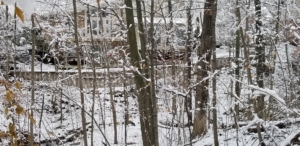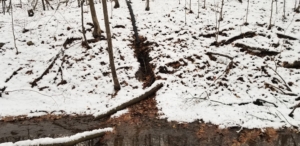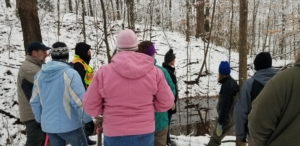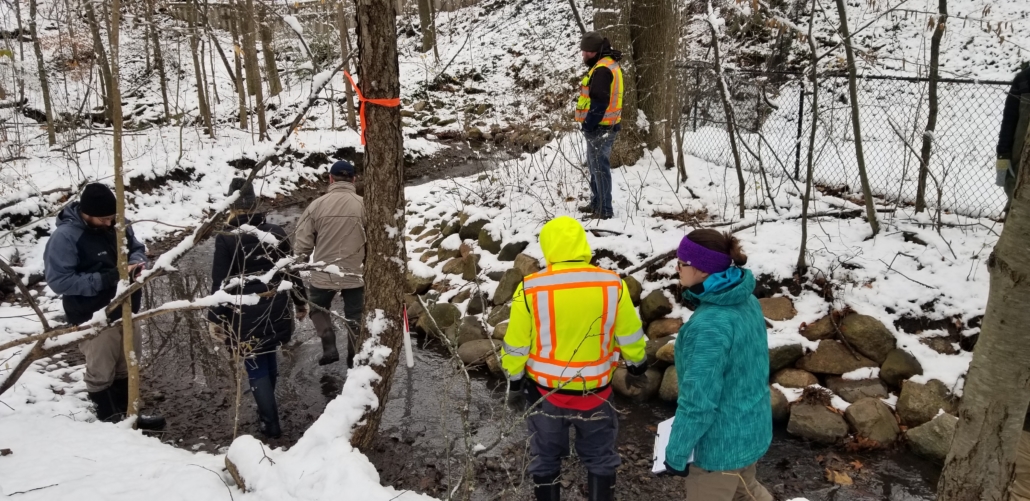By Andrew Blok
A streambank restoration project on Grand Rapids’ southeast side highlights one of the threats of urbanization to streams and rivers.
The project aims to halt erosion that threatens houses and property along a stretch of streambank that lies between Alger Street SE and Golfridge Drive SE. While erosion and changes to a stream’s path are natural, runoff from streets, sidewalks and driveways can flood streams with unnatural amounts of water and kick erosion into overdrive.
A problematic development
In an undeveloped area, rainwater would filter through soil and feed streams more gradually or be stored as ground water. If it instead falls on paved surfaces or roofs, that water is funneled through gutters and storm drains and enters the stream in a rush at culverts and storm drains.
That’s what’s happening here.
“Streams are living, breathing things. Streams change all the time,” said Michael Staal, Grand Rapids’s acting project manager for the ravine restoration. But development can accelerate the natural erosion to problematic levels, Staal said.

Years ago, home owners whose property backed up to the creek, noticed the bank was eroding at an alarming rate, Staal said. They reached out to the City to see what could be done. At the time, the City added some riffles (shallow steps down within a stream) to address the problem.
Now, four or five years later, erosion concerns popped up again, this time upstream from the river.
The problematic erosion is likely coming from a culvert that drains over a 26-acre residential area, according to a study of the area commissioned by the City.
That rush of water accelerates erosion and alters the natural erosion patterns a stream undergoes.
A plan for restoration
One solution to erosion is streambank and channel improvements. This includes establishing streamside vegetation with roots that can hold soil in place. Also, well-placed boulders and logs can slow the stream’s flow and mitigate erosion. Within the stream, the City can reintroduce natural stream features to decrease the stream’s slope and speed. Pools in steep areas can slow the water enough to slow erosion. Logs in the stream can slow water and direct it away from eroded portions of the bank.
The City is still planning with Holland Engineering, who will make the improvements in the stream, and the Michigan Department of Environment, Great Lakes and Energy (EGLE), which is providing a grant to fund part of the project.
Staal hopes the improvements in the stream will happen starting next fall. The grant money doesn’t expire until November 2021, so the schedule can be flexible if the weather doesn’t cooperate.
Slow the flow with green solutions
Along with the grant, EGLE wanted part of the plan to focus on diverting water before it gets to the ravine.
Rain barrels and rain gardens can divert water from the storm drains. Rain gardens that replace lawn or impermeable surfaces allow more water to filter through the soil. The USDA says, “By capturing rainwater in a rain garden, holding it, and then slowly releasing it into the soil, the rush of runoff from a large storm can be slowed and cleaned – quickly, neatly and naturally.” Native plants in rain gardens hold more water than turf grass. A study of rain garden’s effectiveness in Burnsville, Minnesota, showed rain gardens can reduce runoff from a neighborhood by 90%.

The Lower Grand River Organization of Watersheds and Plaster Creek Stewards are conducting free site assessments to help homeowners find places appropriate for rain gardens on their property.
Unfortunately, buried utility lines made digging curbside rain gardens impossible, Staal said. So, the focus on green infrastructure shifted to rain barrels.
Rain barrels capture water from roofs for use at a later time. According to a public service announcement linked from the United States EPA’s website, a single roof can shed 24,000 gallons of water a year. A regularly used rain barrel can capture 855 gallons a year that won’t reach storm drains like the one causing erosion at the Alger/Golfridge Ravine.
“I would like to see a rain barrel on every house,” Staal said. Aside from helping the stream they can save homeowners money when they use a rain barrel instead of city water to water flowers or vegetables.
Solutions in action
WMEAC has hosted two rain barrel workshop this fall, near the ravine project. Additional workshops will be held next year and in 2021. These workshops will teach participants about controlling stormwater runoff to the ravine and how to assemble their own rain barrel, which they can take home with them. It’s a good first step in addressing the runoff problem causing the erosion in the ravine.
The project excites Staal because it’s near the stream’s origination.
“If you take care of problems upstream, you know they’re not going to be causing problems downstream,” he said. Community enthusiasm for a project like this (which he credits for helping get the grant from EGLE) means good things, not just for the ravine in backyards on Golfridge Drive, but for everyone downstream in the watershed, too.
“This isn’t going to solve all the problems down stream,” Staal said.
But it’s not going to hurt either.
WMEAC visits the ravine

WMEAC Water Fellow Andrew Fishback recently visited the ravine. His report follows:
On December 2, 2019, a surveying team took to the Alger Ravine to measure the streambed. This way we will be able to understand how this stream naturally behaves, allowing us to pair this situation with the optimal erosion mitigation practices. The big ticket mitigator here would be rain barrels and rain gardens. Both of which create a delay between the water reaching the ground and the water running over the hillside, feeding the stream.
Lead photo courtesy Andrew Fishback.


